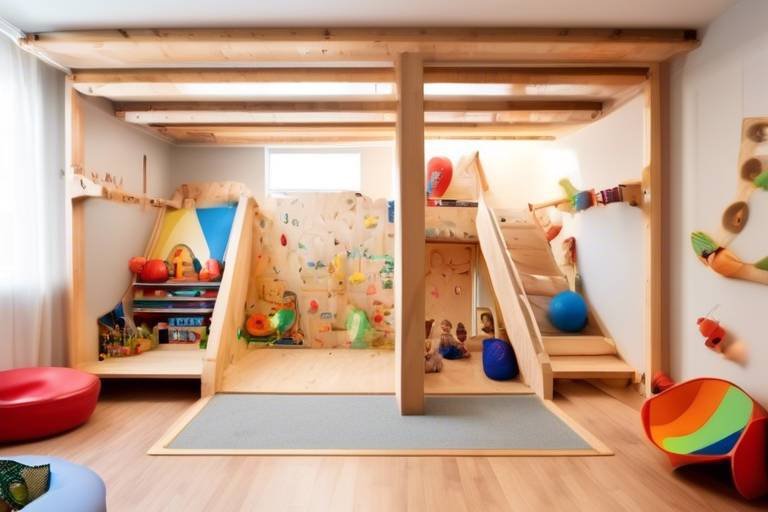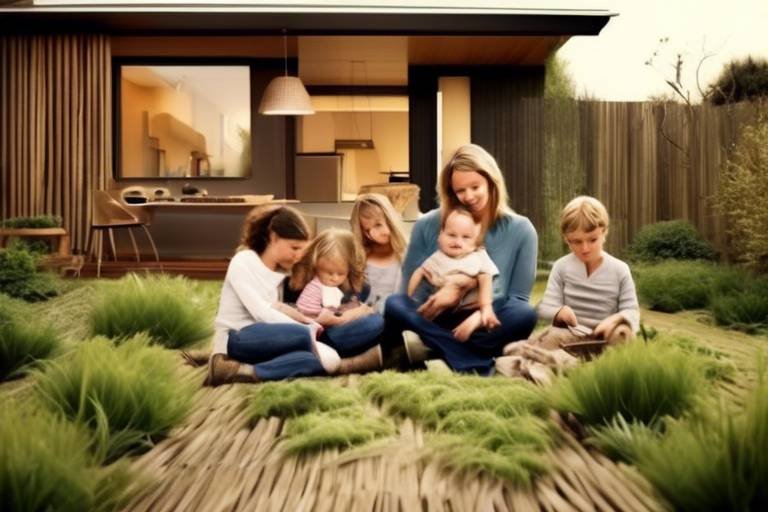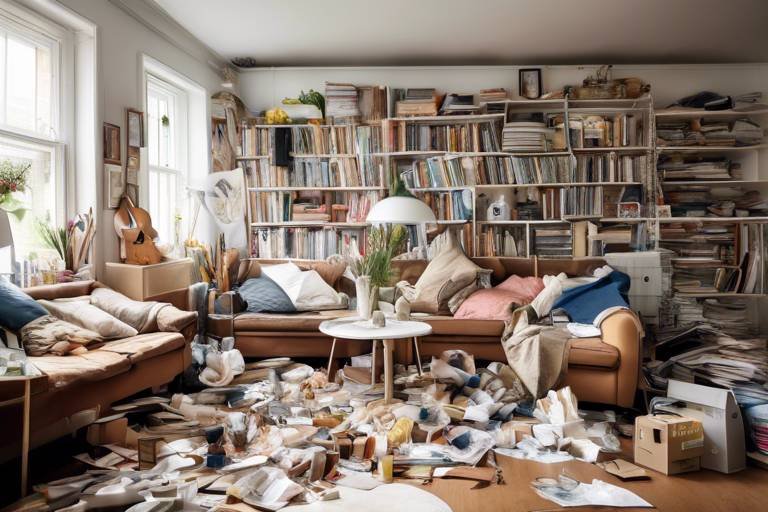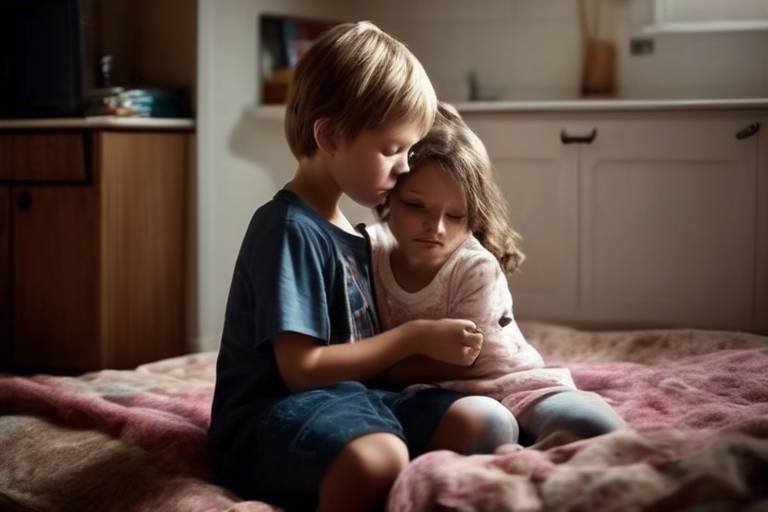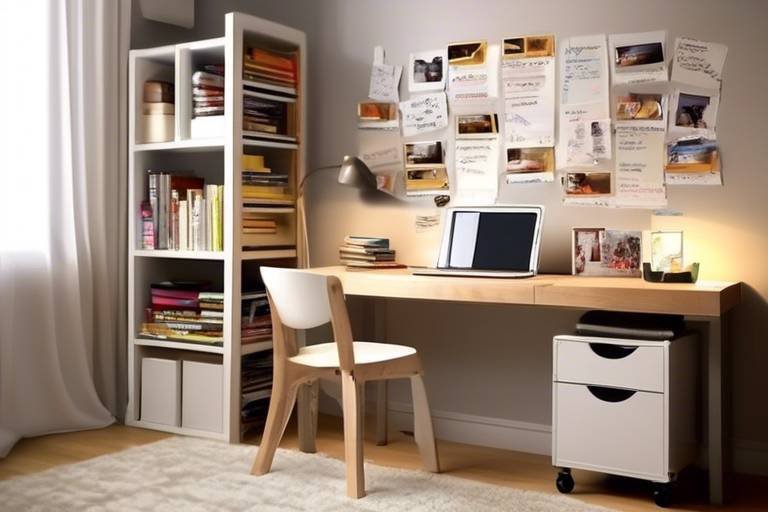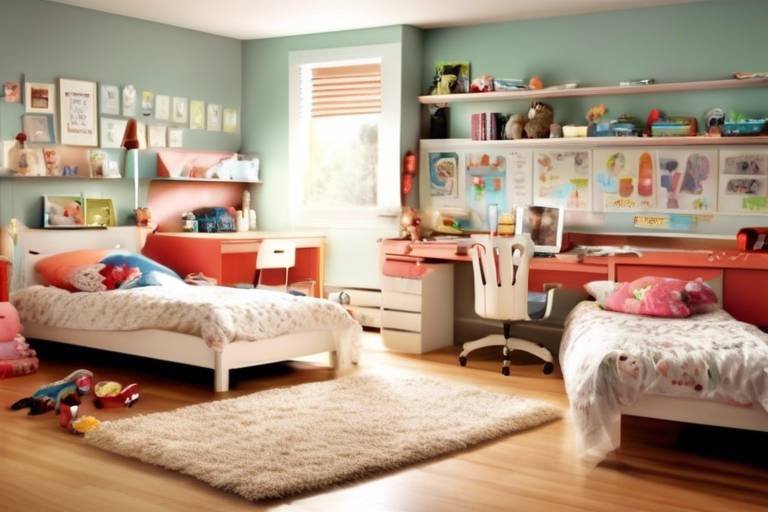Creating Indoor Play Areas for Kids in Small Spaces
Designing an indoor play area for kids, especially in small spaces, can feel like trying to fit a square peg into a round hole. But fear not! With a sprinkle of creativity and a dash of practicality, you can transform even the tiniest nooks into vibrant play zones. Think of your space as a blank canvas, ready to be filled with laughter, joy, and imagination. This article dives into innovative ideas and practical tips that will help you create engaging indoor play areas, ensuring that fun and safety go hand in hand.
When it comes to small spaces, maximizing vertical space is crucial. Instead of letting those walls go to waste, why not utilize them? Wall-mounted shelves can serve as perfect storage for books and toys, while also providing a fun climbing structure for adventurous little ones. Imagine a wall filled with colorful shelves, each holding a treasure trove of toys just waiting to be explored. Not only does this free up valuable floor space, but it also encourages children to engage in physical activity, climbing up to reach their favorite items. Think of it like creating a vertical playground right in your living room!
In a world where space is at a premium, multi-functional furniture becomes your best friend. Picture a cozy storage bench that doubles as seating for storytime or a foldable table that can be tucked away when not in use. These versatile pieces not only save space but also keep your play area organized and flexible. By incorporating furniture that serves dual purposes, you can create a dynamic environment where kids can play, learn, and grow without feeling cramped. It’s like having a Swiss Army knife for your home—compact yet full of possibilities!
Effective storage solutions are essential in small play areas. Imagine stylish bins and baskets that not only look good but also keep toys organized and accessible. You could have a colorful array of storage options that encourage kids to put their toys away after playing. This not only helps maintain a tidy space but also teaches children responsibility. Consider using a
| Storage Type | Benefits |
|---|---|
| Baskets | Easy to access, great for soft toys |
| Bins | Stackable and space-efficient |
| Cabinets | Keep items out of sight, organized |
Let’s not forget about the space under the bed! Under-bed storage is an excellent way to utilize otherwise wasted space. Think of it as a secret hideaway for toys and games, out of sight yet easily reachable. You can use shallow bins or rolling drawers to store everything from puzzles to action figures, making it a breeze for kids to access their favorite toys without cluttering the room.
Wall-mounted organizers can save floor space while keeping play essentials within reach. These clever designs can range from simple hooks for bags to elaborate shelving units that showcase toys. Not only do they blend functionality with aesthetics, but they also encourage kids to take ownership of their space by organizing their own play area. Imagine a wall adorned with bright colors and playful shapes, inviting children to explore and engage!
Dividing the play area into distinct zones can encourage various activities. Think of designating spaces for arts and crafts, reading, and active play. This not only promotes diverse experiences but also helps children understand the importance of different types of play. You could create a cozy reading nook with cushions and bookshelves, a vibrant arts corner with supplies neatly organized, and a dynamic play zone for physical activities. By creating these zones, you’re not just organizing space; you’re fostering creativity and growth!
Natural light can significantly impact a child's play environment. Imagine a sun-drenched room filled with laughter and joy, where children can bask in the warmth of sunlight while they play. Explore ways to maximize sunlight through window placement, mirrors, and light-colored decor. Mirrors can create an illusion of more space while reflecting light, making the area feel brighter and more open. It’s like inviting the outdoors in, creating a cheerful atmosphere that inspires imaginative play!
Light colors and playful patterns can make a small area feel larger and more cheerful. Choosing the right color palette is essential to enhance the play atmosphere. Soft pastels or bright whites can create a sense of openness, while fun patterns can add a touch of whimsy. Imagine a room painted in soft yellow, with a playful jungle-themed rug to spark creativity. This combination can transform a small play area into a vibrant haven for kids!
Safety is paramount in any play area. Ensuring that your space is safe for children involves several essential measures. Soft flooring, rounded furniture edges, and secure storage are just a few of the precautions you can take to create a safe environment. Think of it as building a fortress of fun—where every corner is designed with care to protect your little ones while they explore and play!
Childproofing your indoor play area is vital for preventing accidents. Explore practical tips to secure furniture, cover outlets, and remove hazards for a worry-free play experience. For instance, using corner guards on sharp furniture edges and ensuring that heavy items are anchored to the wall can make a world of difference. It’s about creating a space where parents can relax while their kids embark on adventurous journeys, knowing they are safe!
- What are some budget-friendly ideas for creating a play area? You can repurpose furniture, use DIY storage solutions, and shop at thrift stores for unique finds!
- How can I keep the play area tidy? Regularly involve your kids in cleaning up, and use labeled storage bins to make organization fun!
- What safety measures should I prioritize? Focus on soft flooring, securing furniture, and keeping small items out of reach to prevent choking hazards.

Maximizing Vertical Space
When it comes to creating indoor play areas for kids, especially in small spaces, is a game changer. Think about it: when you’re limited on floor area, why not look up? By utilizing the walls, you can transform any room into a vibrant play zone without sacrificing precious ground space. Imagine shelves filled with colorful toys, wall-mounted climbing structures, and even hanging art stations. It’s like turning your walls into a playground!
One of the most effective ways to enhance play without cluttering the floor is by installing floating shelves. These can serve as both storage and display areas for toys, books, and crafts. Not only do they keep items organized, but they also allow children to easily access their favorite things. You can arrange the shelves at different heights to make it fun for kids to reach for their toys, almost like a treasure hunt! Additionally, consider using wall-mounted toys like pegboards or magnetic boards. These interactive surfaces can hold everything from art supplies to building blocks, making playtime even more engaging.
Another fantastic idea is to incorporate climbing structures that utilize vertical space. Look for options like wall-mounted climbing holds or indoor rock climbing walls that encourage physical activity while being safe and fun. These structures can be designed to fit snugly against a wall, taking up minimal floor space while providing an exciting outlet for your little adventurers. In fact, climbing not only promotes physical fitness but also boosts confidence and problem-solving skills as children figure out how to navigate their climbing routes.
To further enhance the vertical play experience, consider adding hammocks or hanging chairs. These can be suspended from the ceiling or attached to strong wall anchors, providing a cozy nook for reading or relaxing. Kids love the sensation of swinging, and it can be a great way to wind down after an active play session. Just imagine a small corner of the room transformed into a serene reading spot, complete with soft pillows and blankets, all while maintaining a playful vibe!
Lastly, don’t forget about the importance of decorative wall decals or murals. These can not only beautify the space but also inspire creativity and imagination. Consider themes that resonate with your child's interests, whether it’s outer space, jungle adventures, or underwater explorations. A well-decorated wall can spark stories and play scenarios that keep kids engaged for hours. Remember, the key is to think vertically and creatively, turning every inch of your space into an opportunity for fun!
In conclusion, maximizing vertical space is essential when designing indoor play areas for kids in small spaces. By incorporating shelves, climbing structures, and decorative elements, you can create a dynamic and engaging environment that encourages exploration and play. So, look up, get creative, and transform those walls into a playground!

Multi-Functional Furniture
When it comes to creating a fun and engaging indoor play area for kids, especially in small spaces, is a game changer. Imagine a world where every piece of furniture not only serves its primary purpose but also contributes to the play experience. This is where the beauty of versatility shines. For instance, a simple storage bench can transform from a cozy seating area to a treasure trove of toys, making it easier for kids to access their favorite games while keeping the space tidy.
Moreover, foldable tables are another fantastic addition. They can be set up for arts and crafts one moment and then neatly tucked away the next, creating more room for movement and play. This flexibility is crucial in smaller areas where every inch counts. Think of it as a Swiss Army knife for your indoor space—each piece of furniture is designed to do more than just one job, allowing you to maximize the functionality of your area without sacrificing style.
Incorporating multi-functional furniture not only keeps your play area organized but also encourages children to engage in various activities. When kids see a table that can be used for both building blocks and snack time, their imagination can run wild. They start to associate furniture with creativity and exploration rather than just a place to sit or store things. This shift in perspective can foster a more dynamic and interactive play environment.
Here are some examples of that can enhance your indoor play area:
- Storage Ottomans: Perfect for seating and storing toys or games.
- Convertible Sofas: These can easily turn into a play space or a cozy nap area.
- Wall-Mounted Desks: Ideal for arts and crafts that can be folded away when not in use.
Ultimately, the goal is to create a space that feels open and inviting, where children can explore and play freely. By choosing the right pieces of furniture, you can create a seamless blend of functionality and fun. So, as you plan your indoor play area, remember that each item can be more than it seems. With a little creativity, you can turn your small space into a magical world of play!

Storage Solutions
When it comes to creating a play area for kids in small spaces, effective are not just a luxury—they're a necessity. Imagine a world where toys don’t clutter the floor, where every item has its place, and where children can easily access their favorite games without the chaos. This is achievable with the right storage strategies. One of the most innovative ways to keep things organized is by using stylish bins and baskets that not only serve a functional purpose but also add a splash of color and personality to the room. Consider opting for stackable bins which can be arranged vertically, thus utilizing precious vertical space while maintaining a tidy appearance.
In addition to bins, cabinets with sliding doors can be a game-changer. They allow for easy access while keeping everything neatly tucked away. You can even personalize these cabinets by painting them in bright colors or adding fun decals that reflect your child's interests. Furthermore, if you want to take it a step further, think about incorporating open shelving. This not only provides a place for books and toys but also encourages children to engage with their belongings. When they can see their toys, they are more likely to play with them, which promotes creativity and imaginative play.
Another clever storage solution is the use of furniture that doubles as storage. For instance, a storage bench can provide seating for playtime while hiding away toys inside. This multifunctional approach is perfect for small spaces where every square inch counts. You can also add cushions on top of the bench to create a cozy reading nook, making the area even more inviting.
Moreover, consider implementing a color-coded storage system. By assigning different colors to various types of toys—like blue for blocks, green for art supplies, and red for stuffed animals—you can teach children to sort their toys while they clean up. This not only simplifies the organization process but also turns cleanup into a fun game.
Finally, don’t forget about the importance of accessibility. Storage solutions should be child-friendly, meaning that kids should be able to reach their toys without assistance. This encourages independence and responsibility. You might even want to create a “toy rotation” system, where only a few toys are out at a time, while the rest are stored away. This keeps the area less cluttered and makes each toy feel like a new discovery when it’s brought back out.
In summary, effective storage solutions can transform a small indoor play area into an organized, functional, and fun environment. With a little creativity and the right tools, you can create a space where children can play freely without the worry of mess.
- What are the best types of storage for small play areas?
Stackable bins, cabinets with sliding doors, and multifunctional furniture like storage benches are excellent options.
- How can I encourage my child to clean up after playing?
Implementing a color-coded storage system and making cleanup a fun game can encourage children to take responsibility for their toys.
- Is it important for storage solutions to be child-friendly?
Absolutely! Child-friendly storage allows children to access their toys independently, fostering a sense of responsibility and organization.

Under-Bed Storage
Under-bed storage is a game-changer when it comes to maximizing space in a small indoor play area. Think about it: that vast expanse beneath your child's bed is often a forgotten wasteland of dust bunnies and lost toys. Instead of letting it go to waste, why not transform it into a treasure trove of organization? With a little creativity, you can utilize this space to store toys, games, and even craft supplies, keeping them out of sight yet easily accessible when the urge to play strikes.
One of the simplest solutions is to invest in storage bins or drawers designed specifically for under-bed use. These come in various sizes and styles, allowing you to choose ones that fit your decor while providing ample storage. You can opt for clear plastic bins, which make it easy for kids to see their toys at a glance, or decorative fabric bins that add a pop of color and style to the room.
For a more DIY approach, consider using shallow wooden boxes or repurposing old suitcases. Not only do these options provide a unique aesthetic, but they also encourage children to take ownership of their space by personalizing their storage. You can even label each box or suitcase, turning clean-up time into a fun game where kids race to find the right home for their toys.
To ensure safety and ease of access, make sure the storage solutions you choose have smooth edges and are lightweight enough for your child to pull out without much effort. You don’t want a situation where they struggle to reach their favorite toy and end up getting frustrated! Additionally, consider adding wheels to your storage bins for effortless sliding in and out, making the play experience even more enjoyable.
Ultimately, under-bed storage not only helps keep the play area tidy but also teaches kids valuable lessons about organization and responsibility. It’s like having a secret hideaway for their toys—one that encourages creativity while maintaining a clutter-free environment.
- What types of storage bins are best for under-bed storage? Clear plastic bins are great for visibility, while fabric bins can add style. Choose based on your child's needs and the room's decor.
- How can I make under-bed storage accessible for young children? Opt for lightweight bins and consider adding wheels to make sliding them in and out easier.
- Can I use under-bed storage for items other than toys? Absolutely! Under-bed storage is perfect for craft supplies, books, and even seasonal clothing.

Wall-Mounted Organizers
When it comes to maximizing space in a small indoor play area, are a game changer. These clever solutions not only save precious floor space but also keep toys and play essentials neatly arranged and easily accessible. Imagine a wall adorned with colorful bins, shelves, and hooks, all working together to create a vibrant and organized environment where creativity can flourish. It's like turning your walls into a playground of possibilities!
One of the most exciting aspects of wall-mounted organizers is their versatility. You can find a variety of designs that cater to different needs and aesthetics. For instance, a series of floating shelves can hold books, art supplies, or even small toys, allowing your child to showcase their favorite items while keeping them within reach. Similarly, pegboards can be customized with hooks and baskets to store everything from craft materials to sports equipment, making it easy for kids to grab what they need and put it back when they're done.
Additionally, wall-mounted organizers can be an excellent way to introduce fun and educational elements into your child's play area. Consider incorporating a chalkboard or a magnetic board as part of the wall organization. These features not only encourage creativity but also serve as a canvas for learning activities, allowing children to express themselves freely. It's almost like giving them a personal art gallery right in their own play space!
When selecting wall-mounted organizers, it's essential to consider both functionality and safety. Ensure that all organizers are securely mounted and that they can withstand the weight of the items being stored. It's also wise to choose materials that are non-toxic and safe for children. After all, the last thing you want is for a decorative piece to become a safety hazard.
To make the most of your wall-mounted organizers, think about grouping items by category. This not only makes it easy for kids to find what they need but also helps teach them about organization and responsibility. For example, you could have a section dedicated to art supplies, another for books, and a third for toys. This way, children can learn to categorize their belongings, making cleanup a breeze!
In summary, wall-mounted organizers are a fantastic way to enhance your indoor play area while keeping it tidy and functional. They bring a sense of order to chaos and can transform an ordinary wall into a dynamic and engaging space for children to learn and play. So, why not start planning your wall organization today? You might just be surprised at how much more enjoyable your play area can become!
- What are the benefits of using wall-mounted organizers? Wall-mounted organizers help save floor space, keep toys accessible, and promote a tidy environment.
- How can I ensure the safety of wall-mounted organizers? Make sure they are securely mounted and made from non-toxic materials.
- Can wall-mounted organizers be customized? Absolutely! Many organizers come in various designs and can be tailored to fit your child's needs and preferences.

Creating Zones for Different Activities
Creating distinct zones within your indoor play area can transform a small space into an engaging playground for your children. Think of it as designing a mini amusement park right in your home! By dividing the area into specific sections for various activities, you not only foster creativity but also encourage children to explore different interests. Imagine a space where one corner is dedicated to arts and crafts, another for reading, and yet another for active play. This not only helps in organizing the area but also allows children to switch between activities seamlessly, keeping their minds and bodies engaged.
To effectively create these zones, consider using rugs or mats to visually separate each area. For instance, a vibrant rug can signify the arts and crafts zone, while a soft mat can define the reading nook. You can even use furniture to create boundaries—like a bookshelf that acts as a divider for the reading area. This way, children can easily identify where they can engage in specific activities, making it easier for them to transition from one zone to another.
Moreover, think about the types of activities you want to encourage in each zone. For the arts and crafts area, ensure you have easy access to supplies like paper, crayons, and paints. In the reading zone, create a cozy atmosphere with soft lighting and comfortable seating. And for active play, consider incorporating soft play equipment or climbing structures that allow kids to expend their energy in a safe environment.
Here’s a quick breakdown of how you can set up these zones:
| Activity Zone | Essential Items | Design Tips |
|---|---|---|
| Arts & Crafts | Paper, crayons, scissors, glue | Use a colorful rug and wall-mounted shelves for supplies |
| Reading Nook | Books, cushions, blankets | Soft lighting and a cozy corner with seating |
| Active Play | Soft mats, climbing structures, balls | Open space with safety padding on the floor |
By thoughtfully designing these zones, you create a vibrant environment that caters to a range of activities, encouraging children to learn, play, and grow in a stimulating way. Remember, the key is to maintain a balance between fun and functionality, ensuring that each zone not only serves its purpose but also sparks joy and creativity in your little ones.

Incorporating Natural Light
When it comes to creating an engaging indoor play area for kids, natural light plays a pivotal role. It’s not just about aesthetics; sunlight can significantly enhance a child's mood and energy levels. Imagine your little ones playing in a space that feels bright and cheerful, where the sunlight dances across the floor, inspiring creativity and joy. But how do you maximize this precious resource, especially in small spaces? Let's explore some innovative ways to bring the outside in.
First, consider the placement of windows. If you're lucky enough to have windows in your play area, make sure they are unobstructed. Heavy curtains or bulky furniture can block the light, making the space feel cramped and gloomy. Instead, opt for sheer curtains that allow sunlight to filter through while still providing a bit of privacy. If you don’t have windows, don’t despair! Mirrors can work wonders. By strategically placing mirrors on the walls, you can reflect light around the room, making it feel larger and brighter. It’s like creating your own little sunroom!
Another effective method is to use light-colored decor. Walls painted in soft pastels or crisp whites can amplify the effects of natural light, making the area feel airy and spacious. Consider adding playful patterns with wall decals or art that complement the light colors. These elements not only brighten the room but also spark imagination. A bright, inviting space encourages children to explore and engage in various activities, from reading to crafting.
In addition to decor, think about the furniture you choose. Lightweight, light-colored furniture can be easily moved to take advantage of the sun as it moves throughout the day. For example, a small table under a window can become a vibrant arts and crafts station during sunny afternoons. Plus, furniture with reflective surfaces can help bounce light around the room. It’s all about creating a dynamic environment that adapts to the changing light.
Finally, don’t forget about the power of plants! Incorporating indoor plants not only adds a splash of color but also brings a touch of nature indoors. Plants thrive in natural light, so placing them near windows can enhance both their growth and the overall ambiance of the play area. Kids love to interact with nature, and having plants around can encourage them to learn about responsibility and caring for living things.
In summary, incorporating natural light into your indoor play space is all about making thoughtful choices. From window treatments to paint colors, every detail counts. By maximizing sunlight, you can create a vibrant, inviting space that fuels your children's creativity and play. So, let the sunshine in and watch as your indoor play area transforms into a magical haven for your little ones!

Using Light Colors and Patterns
When it comes to designing an indoor play area for kids, the color scheme you choose can work wonders in transforming a small space into a vibrant and inviting haven. Using light colors is like opening a window to the world; it brings in a sense of airiness and freedom, making the area feel larger than it actually is. Imagine stepping into a room painted in soft pastels or bright whites, where the walls seem to whisper joy and creativity. The right shades can energize the atmosphere, making it a perfect backdrop for playtime adventures.
Incorporating playful patterns can also add a layer of excitement and stimulation. Think about how polka dots, stripes, or even whimsical animal prints can spark a child’s imagination. These patterns can be introduced through various elements such as rugs, curtains, or wall decals. For instance, a simple area rug with colorful patterns can serve as a designated play zone, encouraging kids to gather around and unleash their creativity. Moreover, using patterns in moderation can prevent the space from feeling overwhelming; it’s all about finding that perfect balance.
Here are a few tips to consider when selecting light colors and patterns for your indoor play area:
- Choose a Base Color: Start with a light base color for the walls, such as soft beige, pale blue, or mint green. This will create a calming backdrop.
- Add Accent Colors: Introduce brighter accent colors through furniture, cushions, or artwork to create focal points that draw the eye.
- Mix and Match Patterns: Don’t be afraid to mix different patterns, but keep them within a similar color palette to maintain cohesiveness.
Remember, the goal is to create an environment that feels both safe and stimulating. Light colors can evoke a sense of peace, while fun patterns can ignite the imagination. Together, they can transform a small indoor play area into a magical space where children can explore, learn, and grow. So, the next time you think about decorating, consider how these elements can work together to enhance your child's play experience.
1. Why should I use light colors in a play area?
Light colors help make a small space feel larger and more open. They also create a calm and inviting atmosphere for children to play in.
2. Can I mix different patterns?
Absolutely! Mixing patterns can add excitement to the space. Just ensure they share a similar color palette to maintain harmony.
3. What are some good light color options?
Soft pastels like pale pink, light blue, mint green, and creamy beige are excellent choices for a play area.
4. How can I incorporate patterns without overwhelming the space?
Use patterns in moderation—perhaps through rugs, cushions, or wall decals. This way, you can add interest without cluttering the visual space.

Safety Considerations
When it comes to creating a safe indoor play area for kids, prioritizing safety is not just a good idea—it's essential! Children are naturally curious and active, which means that any space designed for play must be carefully considered to minimize risks. From the choice of flooring to the arrangement of furniture, every detail can make a significant difference in ensuring a safe environment. One of the first steps is to choose soft flooring materials, such as foam tiles or carpets, which can cushion falls and provide a comfortable area for play. It's like laying down a safety net that catches their excitement while they leap and tumble!
Another crucial aspect of safety is the furniture. Opt for pieces with rounded edges instead of sharp corners. Imagine a child running around, only to collide with a sharp edge—ouch! Rounded furniture not only looks inviting but also reduces the risk of injuries. Additionally, securing heavy furniture to the wall can prevent tipping accidents. Think of it as anchoring a ship in a storm; it keeps everything steady and safe.
Storage solutions play a significant role in maintaining safety as well. Toys scattered across the floor can create tripping hazards, so investing in stylish bins and baskets is a smart move. These can be placed at a child's height, making it fun for them to put away their toys after playtime. Not only does this keep the area tidy, but it also fosters a sense of responsibility in children. And remember, outlet covers are a must! Covering electrical outlets is a simple yet effective way to prevent curious fingers from exploring dangerous areas.
To further enhance safety, consider implementing a few childproofing tips. For example, use non-toxic materials for any paint or decor items, ensuring that your play area is free from harmful chemicals. It's like creating a safe haven where children can express their creativity without any worries. Additionally, keep small items that could pose a choking hazard out of reach, and regularly check the play area for any potential hazards, such as loose cords or broken toys.
Incorporating these safety measures will not only provide peace of mind for parents but also allow children to explore and play freely. After all, a safe play area is a happy play area! So take the time to assess your space and make necessary adjustments—your little ones will thank you for it!
- What are the best flooring options for a children's play area?
Soft options like foam tiles, carpets, or rubber mats are great choices as they provide cushioning and reduce the risk of injury.
- How can I make my play area more organized?
Invest in storage solutions like bins, baskets, and shelves to keep toys tidy and accessible.
- What safety measures should I take for furniture?
Choose rounded furniture and secure heavy pieces to the wall to prevent tipping.
- Are there specific childproofing tips I should follow?
Use outlet covers, keep small items out of reach, and regularly check the area for hazards.

Childproofing Tips
When it comes to creating a safe indoor play area for your little ones, childproofing is not just a precaution; it's a necessity. Imagine your child as a curious explorer, always on the lookout for new adventures, which often leads them to potential hazards. To ensure their safety while they enjoy their playtime, here are some essential tips that you should keep in mind.
First and foremost, start by securing heavy furniture to the wall. Think about it: a bookshelf filled with toys can be an enticing climbing structure for a toddler. By using brackets or straps, you can prevent it from tipping over, ensuring that your child can play safely without the risk of a dangerous accident. Additionally, it's wise to cover any sharp edges on furniture with corner guards. This simple addition can make a world of difference, turning a potential injury into a worry-free play zone.
Next, consider the importance of outlet covers. Children are naturally inquisitive, and electrical outlets can be particularly tempting. Installing outlet covers will keep tiny fingers from exploring where they shouldn’t. Furthermore, it’s crucial to keep cords from blinds and curtains out of reach. Not only can these pose a strangulation risk, but they can also become a tripping hazard during playtime.
Another vital aspect of childproofing is to create a clutter-free environment. A tidy play area not only looks great but also minimizes the risk of accidents. Use stylish storage solutions like bins and baskets to keep toys organized. This way, your child knows where to find their favorite playthings, and you can avoid the chaos of scattered toys that can lead to slips and falls.
Don't forget about the flooring! Soft, cushioned surfaces can significantly reduce the impact of any falls. Consider investing in interlocking foam tiles or plush rugs. These not only provide a safe landing but also add a fun element to the play area. Plus, they’re easy to clean, making them a practical choice for any parent.
Lastly, always keep an eye on the small items. Toys with tiny parts can be a choking hazard for younger children. Regularly check the play area for any small toys that may have been left out, and encourage your child to play with age-appropriate toys only. Remember, a little vigilance goes a long way in ensuring your child has a safe and enjoyable play experience.
In conclusion, childproofing your indoor play area doesn't have to be a daunting task. By taking these simple yet effective steps, you can create a fun, engaging, and above all, safe environment for your child to explore and play. After all, peace of mind is priceless when it comes to our little adventurers!
- What are the most common hazards in a play area? Common hazards include sharp edges on furniture, electrical outlets, small toys that can be choking hazards, and clutter that can cause trips and falls.
- How can I make my play area more spacious? Utilize vertical space with shelves, use multi-functional furniture, and keep the area organized with effective storage solutions.
- What types of flooring are best for a play area? Soft flooring options like foam tiles, carpets, or rugs provide cushioning for falls and are easy to clean.
- How often should I check the play area for safety? Regularly inspect the play area, ideally once a week, to ensure that toys are age-appropriate and that there are no new hazards present.
Frequently Asked Questions
- What are some creative ways to maximize vertical space in a small play area?
Utilizing vertical space can be a game changer in tiny play areas. Consider installing wall-mounted shelves to hold toys or books, and think about adding climbing structures that go upwards rather than spreading out. Wall-mounted organizers can also keep essentials like art supplies within reach while saving valuable floor space.
- How can I incorporate multi-functional furniture in a play area?
Multi-functional furniture is a fantastic way to keep your play area flexible and organized. Look for storage benches that can double as seating or foldable tables that can be tucked away when not in use. This way, you can create a dynamic environment that adapts to your child's needs.
- What are some effective storage solutions for small play areas?
Keeping toys organized is key in small spaces. Stylish bins and baskets can help contain the chaos while adding a decorative touch. Consider under-bed storage for toys that aren't used daily, and wall-mounted organizers to keep frequently used items easily accessible but off the floor.
- How can I create distinct zones for different play activities?
Dividing your play area into zones can really enhance the experience for your child. Designate specific areas for arts and crafts, reading, or active play. Use rugs or furniture to visually separate these zones, encouraging your child to engage in a variety of activities throughout their playtime.
- What are some tips for incorporating natural light into a play area?
Natural light can make any space feel more inviting and cheerful. Maximize sunlight by placing mirrors strategically to reflect light, and choose light-colored decor that enhances brightness. If possible, position play areas near windows to allow your child to enjoy the benefits of natural illumination.
- How do light colors and patterns affect a small play area?
Using light colors and playful patterns can create an illusion of more space and make the area feel more cheerful. Soft pastels or bright whites can open up the room, while fun patterns can add energy and excitement. Just be sure to balance it out with some neutral tones to avoid overwhelming the senses.
- What safety measures should I consider for an indoor play area?
Safety is crucial in any play area. Ensure you have soft flooring to cushion falls, and opt for furniture with rounded edges to minimize injury risks. Secure storage solutions are also important to prevent tipping and keep hazardous items out of reach. Always keep an eye on potential choking hazards and sharp objects.
- What are some childproofing tips for my indoor play area?
Childproofing is essential for a worry-free play experience. Make sure to secure heavy furniture to the wall, cover electrical outlets, and remove any small items that could pose choking hazards. Regularly check the area for potential dangers, ensuring it's a safe haven for your little ones.

